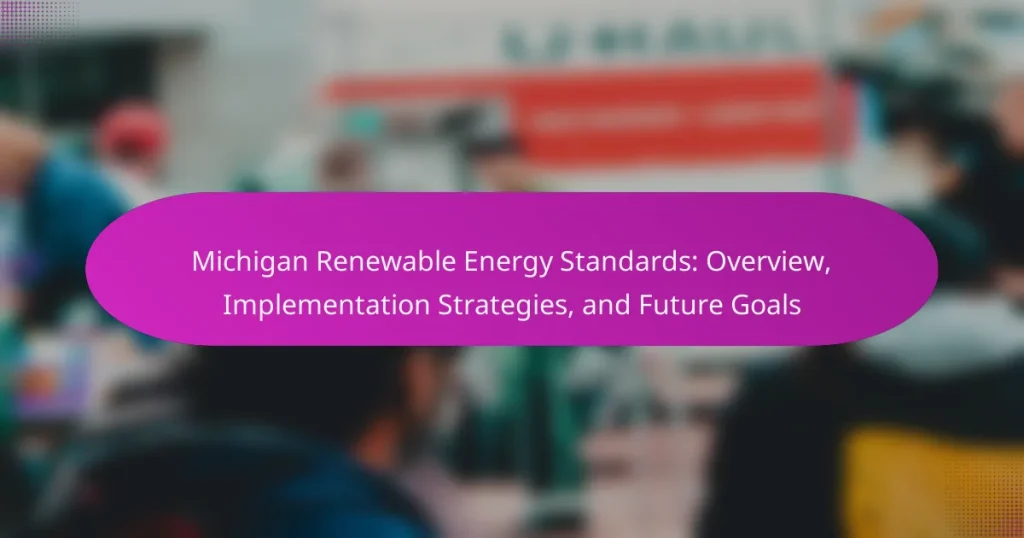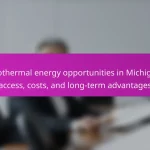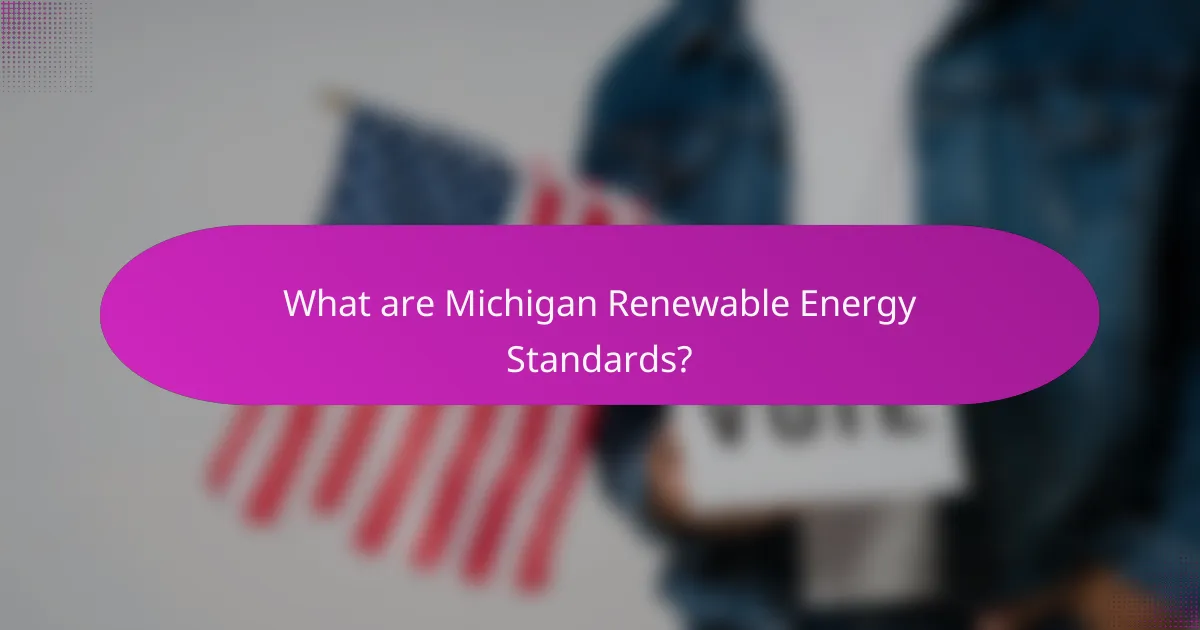
What are Michigan Renewable Energy Standards?
Michigan Renewable Energy Standards are regulations that mandate the use of renewable energy sources in the state. These standards aim to increase the percentage of energy generated from renewable resources. As of 2021, the goal is to achieve 15% renewable energy by 2021, with further objectives to expand this percentage in future years. The standards include specific requirements for utility companies to obtain a certain amount of energy from renewable sources. They also promote the development of wind, solar, and biomass energy projects. The implementation of these standards is overseen by the Michigan Public Service Commission. The standards are part of Michigan’s broader efforts to reduce greenhouse gas emissions and promote sustainable energy practices.
How were Michigan Renewable Energy Standards established?
Michigan Renewable Energy Standards were established through legislative action. The Michigan Public Act 295 of 2008 mandated a renewable energy portfolio standard. This act required utilities to obtain at least 10% of their energy from renewable sources by 2015. The standards were designed to promote the use of wind, solar, and other renewable energy technologies. In 2016, the Michigan legislature passed Public Act 342, which increased the renewable energy goal to 15% by 2021. These legislative measures were aimed at reducing greenhouse gas emissions and enhancing energy security. The standards have been enforced by the Michigan Public Service Commission, which monitors compliance and progress.
What legislative measures support these standards?
The legislative measures that support Michigan’s renewable energy standards include the Clean and Renewable Energy and Energy Waste Reduction Act. This act mandates that utilities must obtain at least 15% of their energy from renewable sources by 2021. Additionally, the 2008 Public Act 295 established a framework for renewable energy development in the state. This act also includes energy efficiency targets for utilities, promoting sustainable practices. Furthermore, the Michigan Energy Efficiency Standards encourage investment in renewable technologies. These measures collectively aim to increase renewable energy usage and reduce greenhouse gas emissions in Michigan.
What historical context led to the creation of these standards?
The historical context leading to the creation of Michigan’s Renewable Energy Standards includes the energy crisis of the 1970s. This crisis highlighted the need for energy independence and sustainability. In response, states began to explore alternative energy sources. The establishment of the Public Utility Regulatory Policies Act in 1978 encouraged renewable energy development. Additionally, growing concerns over climate change in the late 20th century prompted legislative action. By the early 2000s, Michigan faced pressure to diversify its energy portfolio. The Michigan Renewable Energy Standard was enacted in 2008 to promote renewable energy generation. This standard aimed for 10% of electricity to come from renewable sources by 2015.
What is the significance of Michigan Renewable Energy Standards?
Michigan Renewable Energy Standards are crucial for promoting sustainable energy practices. They set specific targets for renewable energy generation. The standards aim for 15% renewable energy by 2021. This initiative encourages investment in clean energy technologies. It also reduces reliance on fossil fuels. The standards contribute to environmental protection by lowering greenhouse gas emissions. Furthermore, they enhance energy security and create local jobs in the renewable sector. Overall, these standards play a significant role in Michigan’s transition to a cleaner energy future.
How do these standards impact energy production in Michigan?
Michigan’s renewable energy standards mandate a transition towards cleaner energy sources, impacting energy production significantly. These standards require utilities to obtain a certain percentage of their energy from renewable sources. As of 2023, Michigan aims for 15% of energy to come from renewables. This shift encourages investment in solar, wind, and other renewable technologies. Increased renewable energy production reduces reliance on fossil fuels. It also contributes to lowering greenhouse gas emissions. The standards foster job creation in the renewable sector. Furthermore, they enhance energy security and stability for Michigan residents.
What role do these standards play in environmental sustainability?
Michigan Renewable Energy Standards play a crucial role in promoting environmental sustainability. These standards mandate a specific percentage of energy to be generated from renewable sources. By increasing the use of solar, wind, and other renewable energies, they reduce reliance on fossil fuels. This transition helps lower greenhouse gas emissions significantly. According to the Michigan Public Service Commission, the state aims for 50% of its energy to come from renewable sources by 2030. This goal aligns with broader climate initiatives to combat global warming. Ultimately, these standards foster a cleaner environment and support sustainable economic growth.
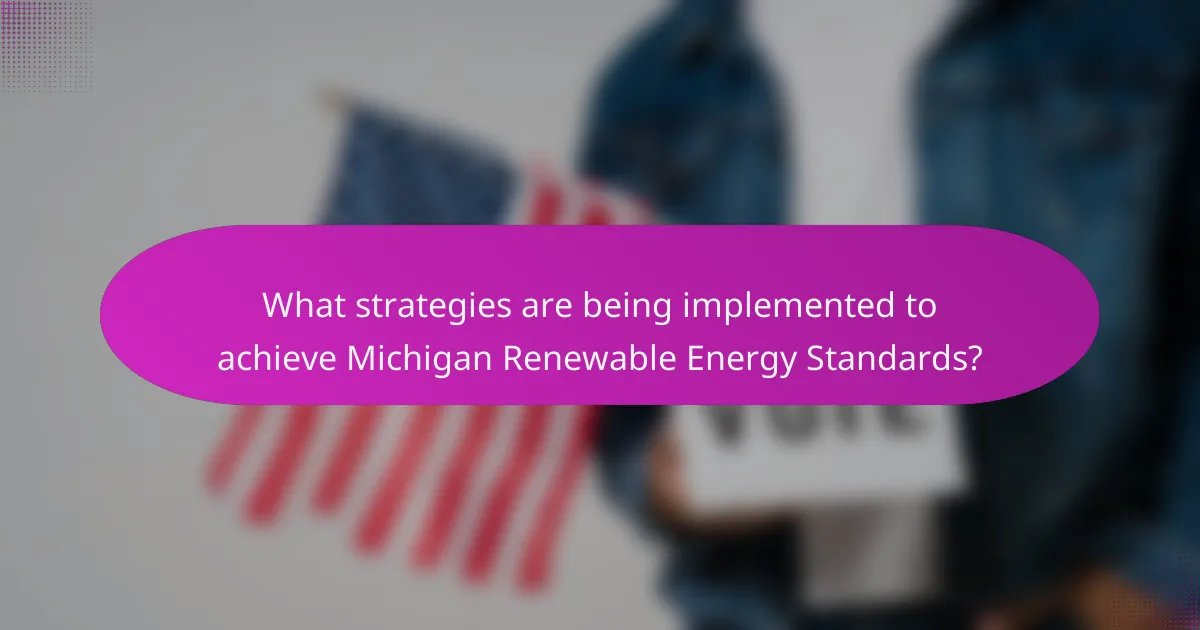
What strategies are being implemented to achieve Michigan Renewable Energy Standards?
Michigan is implementing several strategies to achieve its Renewable Energy Standards. These strategies include increasing renewable energy generation from wind and solar sources. The state has set a goal of 15% renewable energy by 2021 and 35% by 2025. Utilities are required to procure renewable energy credits to meet these standards. Investment in grid modernization is also a key strategy. This includes enhancing infrastructure to support distributed energy resources. Additionally, the state promotes energy efficiency programs to reduce overall demand. The Michigan Public Service Commission oversees compliance and progress toward these goals. These strategies are backed by legislation such as the Clean and Renewable Energy Act.
How are stakeholders involved in the implementation process?
Stakeholders are involved in the implementation process by providing input, resources, and support. They include government agencies, utility companies, and community organizations. Each stakeholder contributes to the development of policies and strategies. For example, government agencies set regulations and standards. Utility companies invest in infrastructure and technology. Community organizations advocate for local needs and concerns. Stakeholder engagement ensures diverse perspectives are considered. This collaboration enhances the effectiveness of renewable energy initiatives. Studies show that inclusive stakeholder involvement leads to better project outcomes.
What roles do government agencies play in this implementation?
Government agencies play crucial roles in the implementation of Michigan Renewable Energy Standards. They establish regulations that guide the development and integration of renewable energy sources. Agencies also monitor compliance with these standards to ensure that energy providers meet mandated renewable energy goals. Additionally, they provide funding and incentives to support renewable energy projects. Government agencies facilitate stakeholder engagement, allowing public input in energy planning. They also conduct research and analysis to inform policy decisions. Through these actions, agencies contribute to achieving Michigan’s renewable energy targets.
How do private companies contribute to the standards’ success?
Private companies contribute to the success of Michigan’s Renewable Energy Standards by investing in renewable technologies. They develop solar, wind, and biomass projects that align with state goals. These companies also create jobs, boosting the local economy. Additionally, they provide expertise and innovation in energy solutions. Collaborations with public entities enhance the effectiveness of implementation strategies. According to the Michigan Public Service Commission, private investments have significantly increased renewable energy capacity in the state. This collaborative approach ensures that standards are met efficiently and effectively.
What technologies are essential for meeting these standards?
Essential technologies for meeting Michigan’s Renewable Energy Standards include solar photovoltaic systems, wind turbines, and energy storage solutions. Solar photovoltaic systems convert sunlight into electricity, providing a clean energy source. Wind turbines harness wind energy to generate power, contributing significantly to renewable energy generation. Energy storage solutions, such as batteries, allow for the storage of excess energy for later use, ensuring reliability and stability in energy supply. These technologies are critical for achieving the state’s renewable energy goals and reducing greenhouse gas emissions.
What renewable energy sources are prioritized in Michigan?
Michigan prioritizes wind energy and solar energy as its main renewable sources. Wind energy accounts for a significant portion of the state’s renewable generation. As of 2021, Michigan has over 3,000 MW of installed wind capacity. Solar energy is rapidly growing, with approximately 2,000 MW of capacity expected by 2025. The state has set a goal to achieve 50% renewable energy by 2030. This commitment is part of Michigan’s broader energy transition strategy. The state also invests in biomass and hydropower, though to a lesser extent. These priorities align with Michigan’s Renewable Energy Standards.
How is energy storage technology integrated into the strategy?
Energy storage technology is integrated into Michigan’s renewable energy strategy to enhance grid reliability and support renewable energy deployment. This integration allows for the storage of excess energy generated from renewable sources, such as wind and solar, during peak production times. The stored energy can then be released during periods of high demand or low generation, ensuring a stable energy supply. Michigan’s strategy includes initiatives that promote the development of battery storage systems and other innovative technologies. These efforts aim to reduce reliance on fossil fuels and improve energy resilience. The state has set specific targets for energy storage capacity, aligning with broader renewable energy goals. This approach not only supports environmental sustainability but also fosters economic growth through job creation in the energy sector.
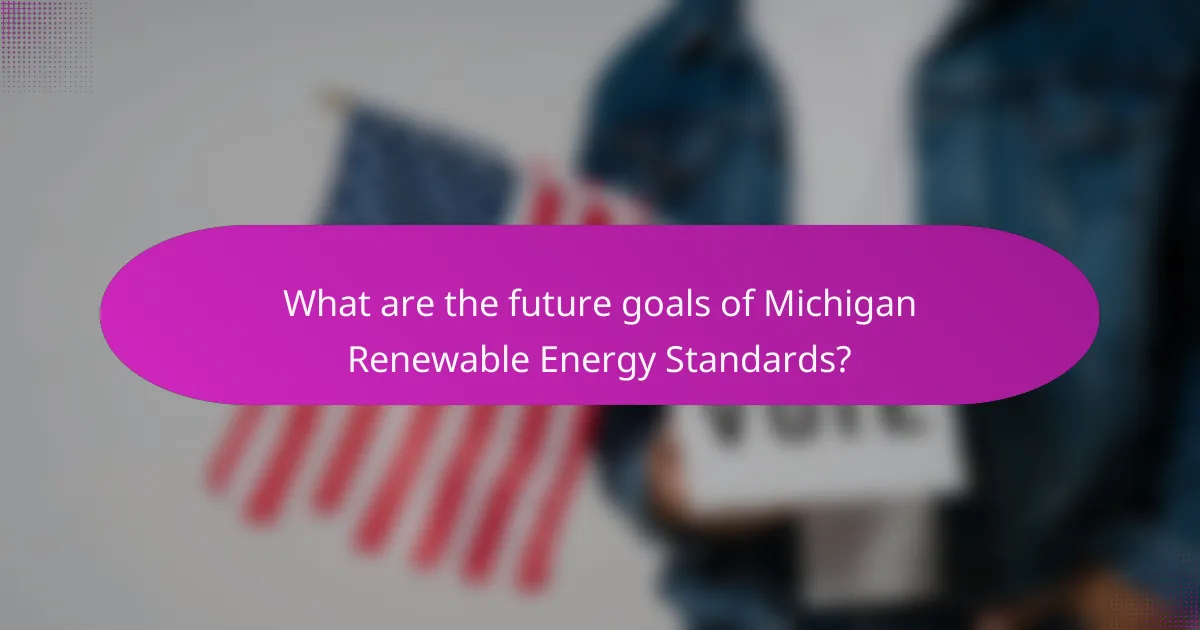
What are the future goals of Michigan Renewable Energy Standards?
The future goals of Michigan Renewable Energy Standards include increasing the renewable energy portfolio to 50% by 2030. This target aims to enhance energy efficiency and promote sustainability. The standards also focus on reducing greenhouse gas emissions significantly. Michigan plans to invest in solar and wind energy projects to meet these goals. By 2040, the state aims for a carbon-neutral electricity sector. These goals are part of a broader strategy to combat climate change and foster economic growth through clean energy jobs. The Michigan Public Service Commission oversees the implementation of these standards.
How does Michigan plan to expand its renewable energy capacity?
Michigan plans to expand its renewable energy capacity through a combination of policy initiatives and infrastructure investments. The state aims to achieve 50% renewable energy by 2030. This goal is supported by the Clean and Renewable Energy Act, which encourages the development of wind, solar, and other renewable sources. Additionally, Michigan is investing in grid modernization to support increased renewable energy integration. The Michigan Public Service Commission is overseeing these efforts and ensuring compliance with renewable energy standards. Recent reports indicate that Michigan has significantly increased its solar capacity, adding over 1,000 megawatts in recent years. These strategies collectively position Michigan as a leader in renewable energy transition.
What specific targets has Michigan set for renewable energy adoption?
Michigan has set a target to achieve 50% renewable energy by 2030. This goal is part of the state’s commitment to transitioning to a clean energy economy. Additionally, Michigan aims for a 100% carbon neutrality target by 2050. These targets are outlined in the state’s energy plan and reflect its focus on reducing greenhouse gas emissions. The state has also implemented policies to support renewable energy investments and development. Specific measures include incentives for solar and wind energy projects. These initiatives aim to enhance the state’s energy security and sustainability.
How will future policies shape the landscape of renewable energy in Michigan?
Future policies will significantly shape the landscape of renewable energy in Michigan. These policies will include increased renewable energy standards and incentives for clean energy development. The state aims to achieve a 50% renewable energy target by 2030. This ambitious goal will drive investments in solar and wind energy projects. Additionally, policies promoting energy efficiency will reduce overall energy consumption. Regulatory frameworks will also support grid modernization to accommodate renewable sources. The transition to electric vehicles will be incentivized, further reducing reliance on fossil fuels. Overall, these policies will foster a sustainable energy economy in Michigan.
What challenges might Michigan face in achieving its renewable energy goals?
Michigan may face several challenges in achieving its renewable energy goals. One significant challenge is the existing infrastructure, which may not support the integration of renewable energy sources. Upgrading or replacing outdated energy systems requires substantial investment and time. Regulatory hurdles can also impede progress, as navigating complex policies may delay project approvals. Additionally, securing funding for renewable projects can be difficult, especially in a competitive financial environment. Public acceptance is another challenge; local opposition can arise due to concerns about land use and environmental impacts. Furthermore, the state must address the intermittency of renewable energy sources, such as wind and solar, which can affect reliability. Lastly, workforce development is crucial; there may be a shortage of skilled labor to support the growing renewable energy sector. These challenges collectively pose obstacles to Michigan’s renewable energy ambitions.
What economic factors could impact the implementation of these standards?
Economic factors that could impact the implementation of Michigan Renewable Energy Standards include funding availability, market demand for renewable energy, and the cost of technology. Funding availability affects the resources allocated for renewable projects. Insufficient funding can delay or limit implementation efforts. Market demand influences the viability of renewable energy investments. Higher demand can encourage more projects and innovation. The cost of technology, including solar panels and wind turbines, directly affects project feasibility. If costs remain high, fewer projects may be initiated. Additionally, regulatory costs and incentives can also play a significant role in shaping the economic landscape for these standards.
How might public perception influence renewable energy initiatives?
Public perception significantly influences renewable energy initiatives in Michigan. Positive public opinion can lead to increased support for policy changes. This support can result in higher funding for renewable projects. For instance, surveys show that 70% of Michiganders favor expanding renewable energy sources. In contrast, negative perceptions can hinder progress and reduce investment. Misinformation about renewable technologies can create resistance. Public engagement and education are crucial in shaping favorable views. Successful initiatives often involve community input and transparency. This approach fosters trust and encourages participation in renewable energy programs.
What best practices can be adopted to support Michigan Renewable Energy Standards?
Adopting best practices to support Michigan Renewable Energy Standards includes enhancing public awareness and education on renewable energy. This involves creating informative campaigns about the benefits and opportunities of renewable energy sources. Collaboration among stakeholders is essential. Engaging utilities, government agencies, and community organizations can foster a unified approach. Establishing clear regulatory frameworks helps streamline the implementation of renewable technologies. Incentivizing investments in renewable energy projects encourages both private and public sector participation. Utilizing data-driven policies ensures that decisions are based on reliable information. Monitoring and evaluating progress regularly allows for adjustments and improvements in strategies. These practices promote compliance and advancement of Michigan’s renewable energy goals.
How can communities engage in local renewable energy projects?
Communities can engage in local renewable energy projects by forming partnerships with local governments and organizations. They can establish community solar programs to allow residents to invest in shared solar energy. Local governments can create incentives for renewable energy installations, such as tax credits or grants. Communities can also hold informational workshops to educate residents on renewable energy benefits and options. Collaborating with local utilities can facilitate the integration of renewable sources into the grid. Additionally, communities can participate in state-level initiatives that promote renewable energy development. According to the Michigan Public Service Commission, community engagement is essential in achieving the state’s renewable energy goals.
What lessons can be learned from other states’ renewable energy efforts?
States’ renewable energy efforts reveal several key lessons for Michigan. First, strong policy frameworks drive renewable energy adoption. For instance, California’s aggressive renewable portfolio standards have resulted in significant increases in solar and wind energy. Second, investment in grid infrastructure is essential. Texas has expanded its grid to accommodate large-scale wind farms, enhancing reliability. Third, public engagement fosters support for renewable initiatives. States like Massachusetts have successfully involved communities in planning processes. Finally, financial incentives can accelerate growth. New York’s Clean Energy Standard offers tax credits and rebates, boosting renewable energy projects. These lessons can guide Michigan’s renewable energy strategies effectively.
Michigan Renewable Energy Standards are regulatory measures aimed at increasing the state’s use of renewable energy sources, targeting 15% renewable energy by 2021 and 50% by 2030. Established through legislative actions, these standards promote the development of wind, solar, and biomass energy projects while reducing greenhouse gas emissions. The article outlines the historical context, implementation strategies, and future goals of these standards, highlighting the roles of government agencies, private companies, and community stakeholders in achieving renewable energy targets. It also discusses the technologies essential for meeting these standards and the challenges that may arise during implementation.
